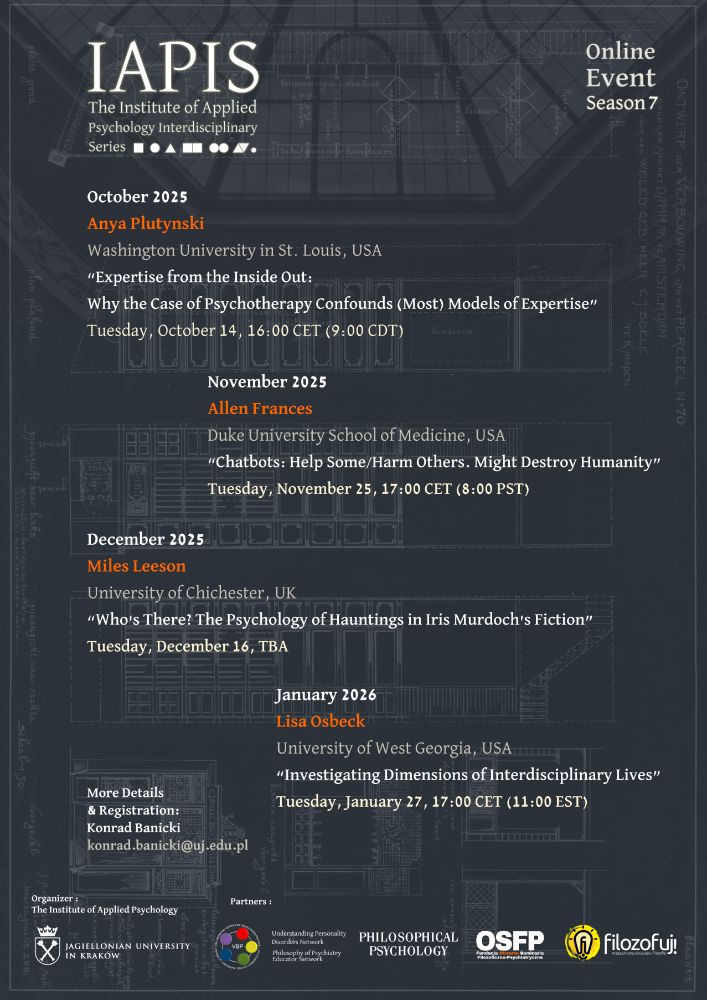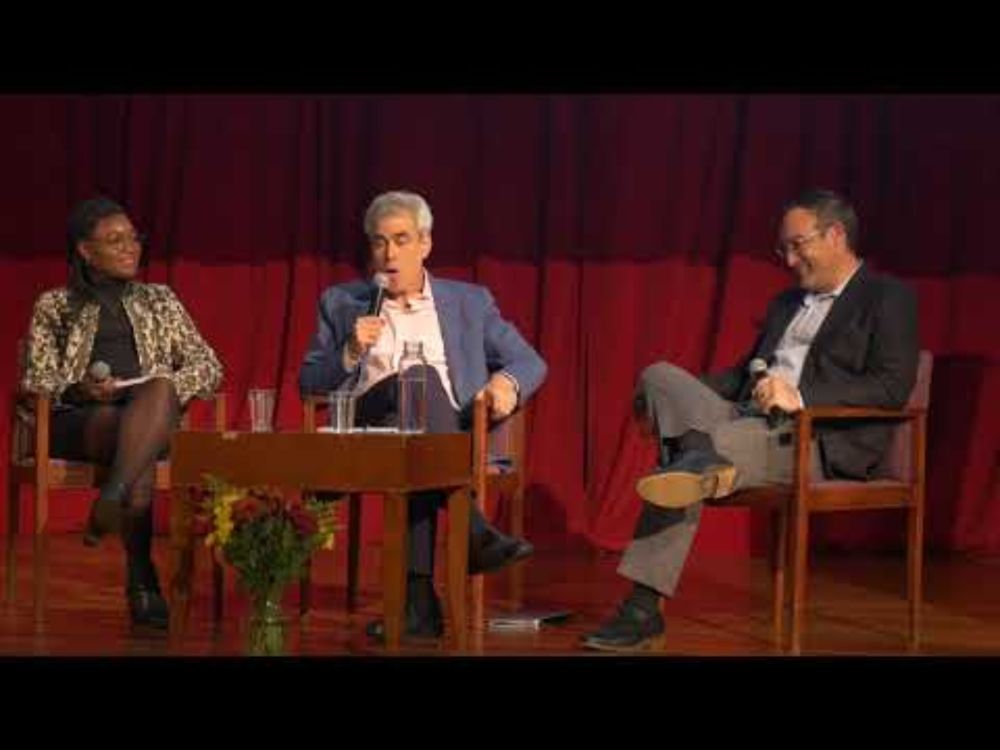
📅 March 20–21, 2026
📍 Kraków, Poland
💬 A space for dialogue on mental health & wellbeing
🎓 Organized by JU’s Institute of Applied Psychology
💡 Theme: “Well-being in Hyperconnectivity”
📝 Register by Dec 31: forms.office.com/e/mAYzFarnvr

📅 March 20–21, 2026
📍 Kraków, Poland
💬 A space for dialogue on mental health & wellbeing
🎓 Organized by JU’s Institute of Applied Psychology
💡 Theme: “Well-being in Hyperconnectivity”
📝 Register by Dec 31: forms.office.com/e/mAYzFarnvr
In order to register for the upcoming Institute of Applied Psychology Interdisciplinary Series event please use: t.co/6vqBnD4wQO

In order to register for the upcoming Institute of Applied Psychology Interdisciplinary Series event please use: t.co/6vqBnD4wQO
www.youtube.com/watch?v=Qh-k...

www.youtube.com/watch?v=Qh-k...
To register for the first talk use: forms.gle/GcnHuj3rhamH...

To register for the first talk use: forms.gle/GcnHuj3rhamH...
In the Final Chapter of our volume Louise Williams presents the Three-Tiered Narrativism & shows how this framework can differentiate individuals with pathological narcissism from healthy personalities and be used for other theoretical purposes.
Link: doi.org/10.1017/9781...

In the Final Chapter of our volume Louise Williams presents the Three-Tiered Narrativism & shows how this framework can differentiate individuals with pathological narcissism from healthy personalities and be used for other theoretical purposes.
Link: doi.org/10.1017/9781...
In Chapter 21 @susi_ferrarello discusses the affectivity of those suffering from narcissistic traits through the lenses of passive, active & practical intentionality as expounded by Husserl. Both the narcissistic wound & “intentional blockage” are explored.
Link: doi.org/10.1017/9781...

In Chapter 21 @susi_ferrarello discusses the affectivity of those suffering from narcissistic traits through the lenses of passive, active & practical intentionality as expounded by Husserl. Both the narcissistic wound & “intentional blockage” are explored.
Link: doi.org/10.1017/9781...
In Chapter 20 Thomas Schramme scrutinizes empathy deficits in the context of NPD and shows how might lead to interpersonal misunderstanding and persistent doubt about other people’s perspectives and about one's own social standing.
Link: doi.org/10.1017/9781...

In Chapter 20 Thomas Schramme scrutinizes empathy deficits in the context of NPD and shows how might lead to interpersonal misunderstanding and persistent doubt about other people’s perspectives and about one's own social standing.
Link: doi.org/10.1017/9781...
In Chapter 19 Nancy N. Potter carries on the discussion of BPD and, in particular, subjects the criterion of emptiness to analysis. She also explores emptiness as found in other diagnoses, everyday life & cross-culturally as well as some treatment possibilities.
Link: doi.org/10.1017/9781...

In Chapter 19 Nancy N. Potter carries on the discussion of BPD and, in particular, subjects the criterion of emptiness to analysis. She also explores emptiness as found in other diagnoses, everyday life & cross-culturally as well as some treatment possibilities.
Link: doi.org/10.1017/9781...
In Chapter 18 Astrid Fly Oredsson & Kasper Lippert-Rasmussen analyse the “inappropriate anger criterion” of BPD and how the openness of the criterion heightens the risk of both testimonial and affective injustice.
Link: doi.org/10.1017/9781...

In Chapter 18 Astrid Fly Oredsson & Kasper Lippert-Rasmussen analyse the “inappropriate anger criterion” of BPD and how the openness of the criterion heightens the risk of both testimonial and affective injustice.
Link: doi.org/10.1017/9781...
In Chapter 17 Grant Gillett & Armon J. Tamatea explore aversive and antagonistic personality disorder in terms of post-colonial analysis of indigenous populations or, in other words, in the context of the loss of ‘the village needed to raise a child’.
Link: doi.org/10.1017/9781...

In Chapter 17 Grant Gillett & Armon J. Tamatea explore aversive and antagonistic personality disorder in terms of post-colonial analysis of indigenous populations or, in other words, in the context of the loss of ‘the village needed to raise a child’.
Link: doi.org/10.1017/9781...
For updates about new lectures do get in touch with [email protected]
More details see: ips.uj.edu.pl/nauka/iapis/...

For updates about new lectures do get in touch with [email protected]
More details see: ips.uj.edu.pl/nauka/iapis/...
In Chapter 16 Garson Leder & Tadeusz Zawidzki reexamine Louis Charland’s influential argument that Cluster B PDs are moral, not medical, conditions with a special focus on the role played by self-regulation in healing.
Link: doi.org/10.1017/9781...

In Chapter 16 Garson Leder & Tadeusz Zawidzki reexamine Louis Charland’s influential argument that Cluster B PDs are moral, not medical, conditions with a special focus on the role played by self-regulation in healing.
Link: doi.org/10.1017/9781...
In Chapter 15 @Castalia1981 employs the notions of dialectics (Tillich), radical acceptance (Linehan's #DBT) and radical opennes (Lynch's #RODBT) to discuss the existential and spiritual dimensions of personality disorders
Link: doi.org/10.1017/9781...

In Chapter 15 @Castalia1981 employs the notions of dialectics (Tillich), radical acceptance (Linehan's #DBT) and radical opennes (Lynch's #RODBT) to discuss the existential and spiritual dimensions of personality disorders
Link: doi.org/10.1017/9781...
In Chapter 14 Annemarie Köhne & Adela-Maria Isvoranu address the comorbidity of personality disorders and mental disorders without implying a latent variable perspective.Rather, they propose to understand mental states and personality traits as related systems.
Link: doi.org/10.1017/9781...

In Chapter 14 Annemarie Köhne & Adela-Maria Isvoranu address the comorbidity of personality disorders and mental disorders without implying a latent variable perspective.Rather, they propose to understand mental states and personality traits as related systems.
Link: doi.org/10.1017/9781...
In Chapter 13 Huw Green attempts to synthesize the view of personality disorders as maladaptive clinical phenotypes with the one of responses to early life events that are understandable in the context they had arouse in.
Link: doi.org/10.1017/9781...

In Chapter 13 Huw Green attempts to synthesize the view of personality disorders as maladaptive clinical phenotypes with the one of responses to early life events that are understandable in the context they had arouse in.
Link: doi.org/10.1017/9781...

In Chapter 12 Simon Boag evaluates the theoretical soundness of the Five Factor Model trait approach as a basis for comprehending personality pathology and proposes an alternative integrative model.
Link: doi.org/10.1017/9781...

In Chapter 12 Simon Boag evaluates the theoretical soundness of the Five Factor Model trait approach as a basis for comprehending personality pathology and proposes an alternative integrative model.
Link: doi.org/10.1017/9781...
Personality disorders, as seemingly more closely related to 'who one is' (than to a disorder 'one has') may invoke a specific kind of self-illness ambiguity. The latter topic is discussed by Roy Dings, Nina S. de Boer, Léon de Bruin & Gerrit Glas in Chapter 11.
Link: doi.org/10.1017/9781...

Personality disorders, as seemingly more closely related to 'who one is' (than to a disorder 'one has') may invoke a specific kind of self-illness ambiguity. The latter topic is discussed by Roy Dings, Nina S. de Boer, Léon de Bruin & Gerrit Glas in Chapter 11.
Link: doi.org/10.1017/9781...
In Chapter 10 Colin G. DeYoung & Robert F. Krueger draw on their cybernetic dysfunction theory of psychopathology as a persistent failure to move toward one’s goals in order to to clarify the role of personality in mental disorder.
Link: doi.org/10.1017/9781...

In Chapter 10 Colin G. DeYoung & Robert F. Krueger draw on their cybernetic dysfunction theory of psychopathology as a persistent failure to move toward one’s goals in order to to clarify the role of personality in mental disorder.
Link: doi.org/10.1017/9781...
In Chapter 9 Simone Cheli & Martin Brüne suggest that both temperamental and developmental components of personality progressively shape autopoietic processes in accordance with the theory of evolution and, especially, Life History Theory.
Link: www.cambridge.org/core/books/a...

In Chapter 9 Simone Cheli & Martin Brüne suggest that both temperamental and developmental components of personality progressively shape autopoietic processes in accordance with the theory of evolution and, especially, Life History Theory.
Link: www.cambridge.org/core/books/a...
In Chapter 8 Stefan Jerotic and Milutin Kostic undertake an in-depth examination into the application of psychopharmacology in the treatment of personality disorders with a special emphasis on the debates about using medication for personality enhancement.
Link: t.co/7lgHHGtvHA

In Chapter 8 Stefan Jerotic and Milutin Kostic undertake an in-depth examination into the application of psychopharmacology in the treatment of personality disorders with a special emphasis on the debates about using medication for personality enhancement.
Link: t.co/7lgHHGtvHA

In Chapter 7 Anna Sterna, Marcin Moskalewicz, Philipp Schmidt-Boddy & Thomas Fuchs shed light on phenomenological aspects of personality disorders with a special emphasis on lived temporal inflexibility of the self.
Link: t.co/lVm5VNK1ub

In Chapter 7 Anna Sterna, Marcin Moskalewicz, Philipp Schmidt-Boddy & Thomas Fuchs shed light on phenomenological aspects of personality disorders with a special emphasis on lived temporal inflexibility of the self.
Link: t.co/lVm5VNK1ub
In Chapter 6 Aidan Wright & Sienna Nielsen apply the Contemporary Integrative Interpersonal Theory to understand the self and social impairments that define personality disorders as a group (with a particular emphasis on interpersonal experience and expression)
Link: t.co/5cYodkvrY5

In Chapter 6 Aidan Wright & Sienna Nielsen apply the Contemporary Integrative Interpersonal Theory to understand the self and social impairments that define personality disorders as a group (with a particular emphasis on interpersonal experience and expression)
Link: t.co/5cYodkvrY5


